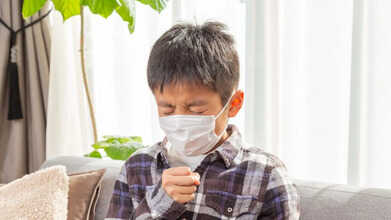- Health Conditions A-Z
- Health & Wellness
- Nutrition
- Fitness
- Health News
- Ayurveda
- Videos
- Medicine A-Z
- Parenting
Why You Are Gaining Weight In Your Hips And Thighs? Here’s What It Could Mean

After a particularly traumatic life event, I had an unsettling change in my body. My lower body—hips, thighs, and buttocks—would gain weight even though I continued to maintain my usual routine. This was not just a cosmetic problem; it felt like my body was trying to tell me something deeper. Like most people, I had undertaken the quest to learn why individuals often gained weight following a stress in life, with many having been established to result from hormonal influences, lifestyle habits, or sometimes from some medical conditions.
For those assigned female at birth, a gain in the lower part of the body is generally related to hormonal influences, mainly estrogen. High levels of this hormone can make it more likely to store fat in the hips, thighs, and pelvis. Although this distribution may seem favorable compared to visceral belly fat—which carries higher risks for heart disease and diabetes—it may become a problem if it makes you fall into an unhealthy weight category.
Any hormonal imbalance, such as irregular periods or unexplained weight shifts, is a reason to discuss this with a healthcare provider. Treatments may include lifestyle modifications, such as cutting back on alcohol or adjusting medications like birth control, under professional guidance.
Stress and Its Effect on Lower Body Weight
Stress is a major contributor to sudden weight changes. It triggers the body's chronic stress response to increase the production of cortisol. Your body may, then store fat in regions, like the thighs and hips. When individuals go through stressful periods, their consumption patterns change or their physical activities become fewer, adding to this case.
The negative effect of stress, however, can be compensated for if one introduces practices that soothe and heal the soul. Techniques that include meditation, yoga, or just staying connected with loved ones can really do the trick. Professional therapy can provide tools to understand and effectively deal with stress.
Sedentary Lifestyle and Lack of Exercise
Modern life often confines us to desks and screens, drastically reducing daily physical activity. Over time, this can lead to fat accumulation in the lower body. The solution? Embrace movement. The Physical Activity Guidelines for Americans recommend at least 150 minutes of moderate-intensity cardio weekly and two sessions of strength training.
Even small changes—like taking the stairs instead of the elevator or pacing during phone calls—can add up. Consistent movement not only helps burn calories but also improves overall health, making it a cornerstone of fat management.
Diet and Nutrition to Balanced Weight
As metabolism slows with age, diet becomes more crucial. A diet rich in processed foods, sugary drinks, and alcohol will contribute to weight gain, especially in areas where your body naturally stores fat.
Replacing one's diet with nutrient-rich foods consisting of lean proteins, whole grains, and fiber-encrusted fruits and vegetables will allow for successful weight management. The Mayo Clinic notes that safely losing 1-2 pounds per week can be achieved by eliminating 500–1,000 calories from one's diet daily. Working with a dietitian will help establish individualized goals for creating lifelong change.
What is Lipedema?
If your lower body weight gain is resistant to diet and exercise, you may want to consider the possibility of lipedema. This condition is characterized by an abnormal buildup of fat in the lower body and is more common in individuals AFAB. It is often associated with hormonal changes during puberty, pregnancy, or menopause.
Lipedema makes the legs heavy and bumpy sometimes causing discomfort. It may involve wearing compression garments, massage therapy that specializes in such conditions, or surgical procedures such as liposuction or bariatric surgery for more extreme conditions. Treatment options need to be consulted by a medical provider first to assess the correct approach.
Ways of Healthy Fat Distribution
Although you can't control entirely where your body stores its fat, developing certain habits can promote healthier fat distribution and risks mitigating that involve visceral fat:
- Choose foods that provide long-term energy with blood sugar spikes minimized.
- Eat healthy fats like avocados, nuts, and olive oil sustain general health without promoting extreme weight gain.
- Aim for 30 minutes every day to increase the intensity of exercise to get the best out of burning fat.
- Find activities that will bring mental and body comfort and avoid stress that leads to the storage of extra fats in the body.
- Prioritize sleep as much as possible sleep for six to seven hours to help your metabolism work well.
- Limit alcohol consumption because too much alcohol causes weight gain and hormonal imbalance.
Knowing the causes of lower body weight gain is the first step to addressing it. Whether it is hormonal changes, stress, or lifestyle factors, embracing sustainable habits can lead to meaningful improvements in your health and well-being.
Disclaimer: This article is for informational purposes only and does not constitute medical advice. Always consult a healthcare professional for personalized guidance regarding weight management and health concerns.
COVID Or Seasonal Flu: NHS Explains What Your Cough May Be Signalling

Credits: Canva
A particular type of cough could offer an important clue about whether you have Covid or flu this winter. The NHS has outlined how the two illnesses can be told apart.
Why Do Respiratory Illnesses Rise In Winter?
As winter arrives, a noticeable increase in seasonal illnesses is expected. Conditions such as the common cold, respiratory syncytial virus (RSV), COVID-19, and influenza tend to spread more easily during colder months. This happens because viruses thrive in lower temperatures and people spend longer periods indoors, often in close proximity to others.
Why Covid and Flu Can Be Hard To Tell Apart
Distinguishing between these infections is not always easy, as many symptoms overlap. According to guidance published by the NHS, the following symptoms are commonly seen in both Covid and flu:
- A high temperature
- A sore throat
- Feeling tired or extremely fatigued
- A headache
- Diarrhoea
- Feeling sick or vomiting
- Loss of appetite
- Coughing is another symptom shared by both conditions, though the nature of the cough can differ.
Cough
Flu and Covid are among the illnesses that become more common during the winter months. If you have influenza, the NHS explains that the cough is usually dry and may develop suddenly, often alongside other symptoms that appear quickly.
In contrast, Covid may cause what the NHS describes as a “new, continuous cough.” This refers to coughing frequently for more than an hour, or experiencing three or more coughing episodes within a 24-hour period.
This distinction is supported by Dr Rupa Parmar, a GP and medical director at Midland Health. In previous comments, she noted that coughs linked to colds are generally mild, while flu tends to cause a dry cough.
“With Covid, the cough is often dry and persistent,” she explained. “Many people cough continuously for long periods or have repeated coughing fits throughout the day.”
Ways To Differentiate Between Covid and Influenza
The type of cough is not the only sign that may help identify which illness you have. A reduced or altered sense of smell or taste is commonly reported in people with Covid and is much less frequent in flu cases.
Breathlessness is another symptom recognised by the NHS as being associated with Covid. While flu can sometimes lead to breathing difficulties, this usually occurs only if the illness becomes severe.
What to do if you have symptoms:
For both Covid and flu, the NHS advises staying at home and limiting contact with others if you or your child have symptoms and either:
- Have a high temperature
- Do not feel well enough to attend work, school, childcare, or carry out normal activities
- The guidance states that normal routines can be resumed once symptoms improve and the temperature returns to normal.
When to seek urgent medical advice:
The NHS recommends contacting your GP or NHS 111 urgently if:
- You are worried about Covid symptoms in yourself or your child and are unsure what to do
- Symptoms are worsening or not improving
- You or your child develop additional signs of illness, such as a rash, poor appetite, or weakness
- A high temperature lasts for five days or more, or does not come down after taking paracetamol
- A baby under three months has a temperature of 38C or above, or is suspected to have a fever
- A child aged three to six months has a temperature of 39C or above, or is suspected to have a fever
- You or your child have flu-like symptoms and you are over 65, pregnant, living with a long-term health condition, have a weakened immune system, or symptoms have not eased after seven days
7 Manifestation Practices To Achieve Your Health Goals In 2026

Every new year brings familiar promises. Eat better. Move more. Quit smoking. Stress less. According to Harvard Health Publishing, the reason these resolutions often fade is not a lack of intent, but the absence of habits that can hold steady once everyday life takes over.
If 2026 is the year you want real, lasting change, the focus needs to shift from short bursts of motivation to health habits that are realistic, repeatable, and kind to your body.
Drawing from insights shared by Harvard Health Publishing, here are seven ways to make health goals finally stick.
1. Choose A Health Goal That Genuinely Motivates You
Harvard Health Publishing notes that goals tied to emotion tend to last longer. Instead of vague aims like “get fit,” think about what truly matters to you. It could be completing a long walk without exhaustion, lowering your blood pressure, or feeling comfortable in your body again. When a goal feels personal, it becomes easier to stay committed.
2. Break Health Goals Into Smaller Daily Actions
Big health goals can feel overwhelming. That is why Harvard Health Publishing recommends breaking them into steps that feel almost too easy. A short walk, a few stretches, or one nutritious meal can build confidence. Small actions done consistently often matter more than dramatic efforts done occasionally.
3. Recognise Why Unhealthy Habits Are Hard To Quit
According to Harvard Health Publishing, many unhealthy behaviours offer immediate comfort. Overeating, smoking, or skipping exercise often meet emotional needs like relaxation or relief from stress. Instead of ignoring this, acknowledge it. Find healthier ways to take breaks, unwind, or reward yourself so you are not fighting against your own needs.
4. Create Accountability Around Your Health Goals
Harvard Health Publishing highlights the role of accountability in sustaining behaviour change. Sharing your goal with a partner, friend, doctor, or even a small online group can make a difference. When others know what you are working toward, you are more likely to stay consistent, especially on difficult days.
5. Reward Progress, Not Just Results
Health improvements happen gradually. Harvard Health Publishing encourages celebrating effort along the way. Acknowledge days when you move your body, eat mindfully, or manage stress better. These small rewards reinforce the habit and prevent burnout caused by waiting only for visible results.
6. Use Setbacks As Learning Moments
Missing workouts or slipping into old habits does not mean failure. Harvard Health Publishing advises viewing setbacks as useful feedback. If a plan feels too demanding, scale it back. If time is an issue, break exercise into shorter sessions. Adjusting your approach makes long-term success more likely.
7. Be Grateful For What You Manage To Do
Perfection is not required for better health. As Harvard Health Publishing reminds us, even small amounts of physical activity or healthier choices benefit the body. Ten minutes of movement is still movement. One balanced meal still nourishes you. Gratitude for effort keeps motivation steady and realistic.
Levothyroxine Thyroid Medicine: NHS Issues Urgent Warning For Patients

Credits: Canva
The NHS has released a warning for people who take levothyroxine to manage thyroid conditions. With an estimated 33 million prescriptions issued every year across the UK, levothyroxine is among the most frequently prescribed medicines provided by the NHS.
Levothyroxine is mainly used to treat an underactive thyroid, a condition medically known as hypothyroidism. Depending on a patient’s needs and a GP’s assessment, the medicine is usually prescribed either as a tablet or as a liquid taken by mouth.
What Is Levothyroxine?
For many patients, levothyroxine is effective in helping the body restore normal thyroid hormone levels. However, the NHS has stressed that the medication is not suitable for everyone. In certain cases, taking levothyroxine may raise the risk of complications linked to other existing health problems.The NHS website explains that while most adults and children can safely take levothyroxine, there are specific situations where it may not be recommended. These restrictions are based on a person’s medical history and current health conditions.
People Who May Not Be Able to Take Levothyroxine
According to NHS guidance, levothyroxine may not be suitable if any of the following apply:
- You have a heart condition such as angina, heart disease, or heart failure
- You have a condition that affects your adrenal glands
- You have previously suffered a heart attack
- You have an overactive thyroid that produces excess thyroid hormone, known as thyrotoxicosis
- You have diabetes
- You have had an allergic reaction to levothyroxine or another medicine in the past
- You have high blood pressure
- Patients are advised to inform their GP or specialist about any of these conditions before starting treatment.
Levothyroxine: Possible Side Effects to Be Aware Of
Levothyroxine can cause a range of side effects, some of which may require urgent medical attention. Common side effects associated with the medication include:
- Flushing or excessive sweating
- Feeling restless, anxious, or overly energetic
- Difficulty sleeping
- Nausea
- Headaches
- Vomiting
- Shaking or trembling
- Diarrhoea
- Muscle cramps
The NHS notes that this is not a complete list, and other side effects may occur. Patients are advised to read the information leaflet included with their medication for full details.
Levothyroxine: When to Seek Medical Help
Although these side effects can be unpleasant, they are usually mild and do not typically require a hospital visit. If symptoms persist or become troublesome, the NHS recommends speaking to a doctor or pharmacist for advice.
However, certain symptoms should not be ignored. If you notice a fast or irregular heartbeat while taking levothyroxine, you should contact a doctor or call NHS 111 as soon as possible.
More serious symptoms require immediate action. Anyone experiencing chest pain while on levothyroxine is advised to call 999 without delay, as this could signal a medical emergency.
Disclaimer: This article is for general information only and is not a substitute for medical advice. Levothyroxine should be taken only as prescribed by a qualified healthcare professional. Do not start, stop, or change your medication without consulting your doctor. If you experience severe symptoms or a medical emergency, seek immediate medical attention or call emergency services.
© 2024 Bennett, Coleman & Company Limited

